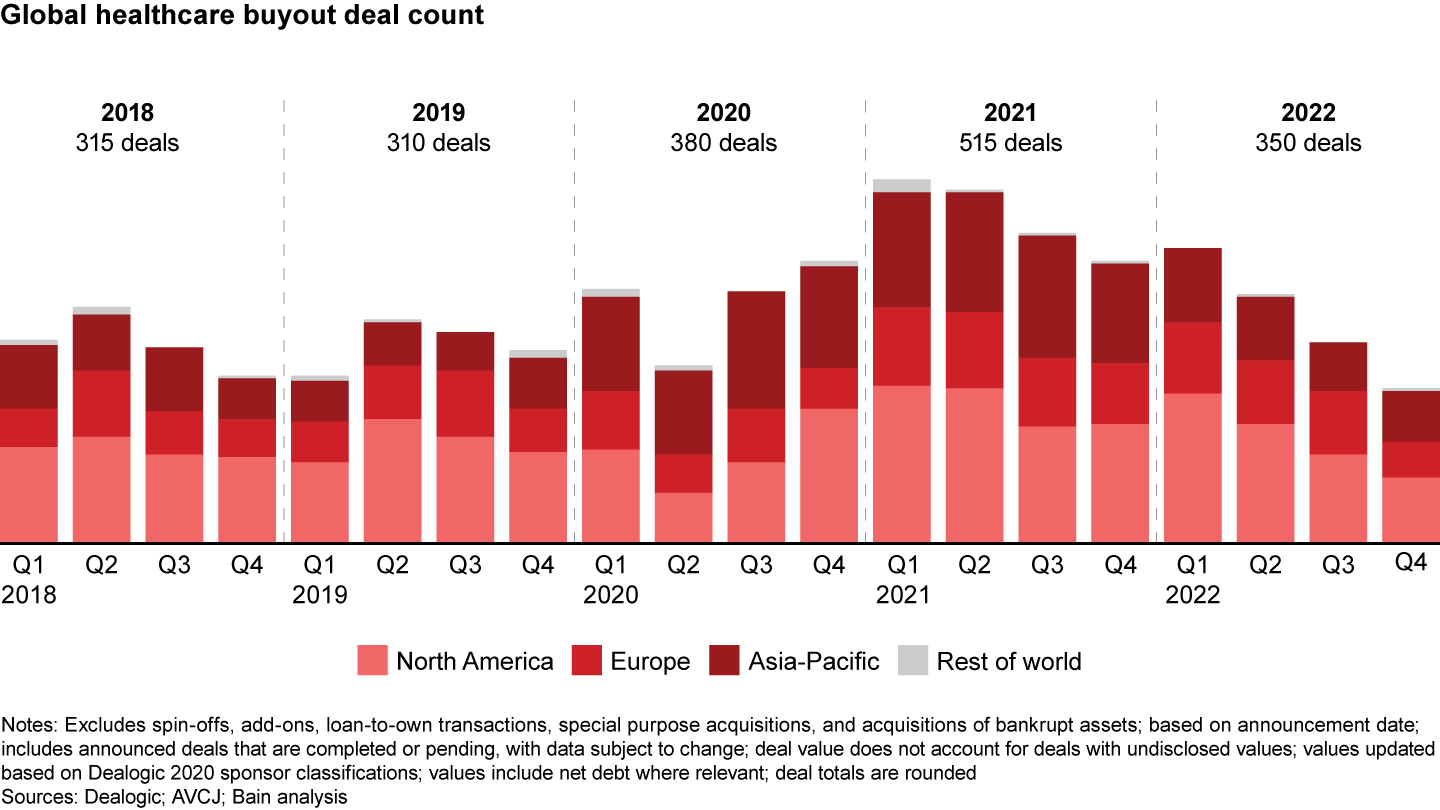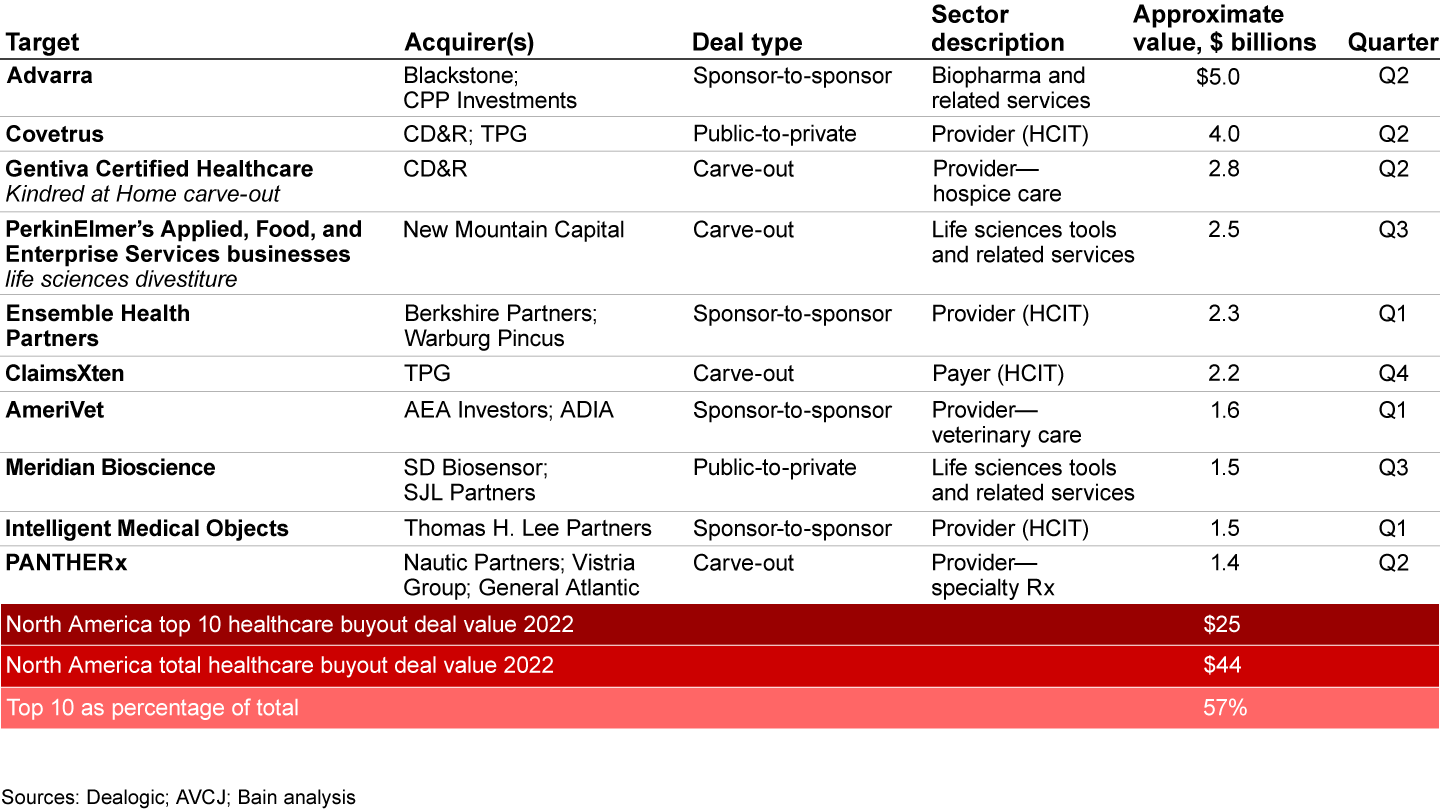Global Healthcare Private Equity Report

At a Glance
- North America healthcare deal activity logged its second-best year in 2022, but the year proved to be a tale of two very different halves.
- Despite such difficulties, the biopharma and life sciences tools sectors collectively grew in deal volume and value.
- Provider remained the most active sector, but labor shortages and wage inflation are likely to give investors pause into 2023.
- Despite the decline in transactions in the second half, we expect a strong recovery of healthcare private equity deal activity, though the exact timing is uncertain.
This article is part of Bain's 2023 Global Healthcare Private Equity and M&A Report.
Deal activity got off to a strong start in 2022: First-half volume exceeded that of the second half of 2021, while disclosed deal value was lower than 2021, which featured the mammoth $34 billion Medline and $17 billion Athenahealth deals. Starting in the third quarter, however, the macroeconomic environment began to impact North American buyout activity. Growing inflationary pressures, mounting Federal Reserve rate hikes, tightening credit conditions, rising geopolitical tensions from the war in Ukraine, and escalating concern over the slowing economy weighed on deal volume and value in the second half. While 2021 saw an average of roughly 50–60 deals announced each quarter, the second half of 2022 saw just 30 deals per quarter on average—a much steeper fall-off in volume than the European and Asia-Pacific markets (see Figure 1). Of those deals over $1 billion, only around 30% were announced in the second half, reflecting the difficulty in securing large-check financing.


The economic situation impacted exits as well. IPOs, which accounted for roughly 25% of exits by volume in 2021, practically vanished in 2022. That share of exit volume was absorbed by corporations flush with cash after a stellar 2021. Strategic exits made up nearly 60% of exits in 2022 vs. the roughly 40% average from 2017 to 2021. On the plus side, depressed public market valuations presented buying opportunities for some. Six of the top 10 deals were carve-outs or public-to-private transactions. Overall, public-to-private and carve-out deal value represented around 44% of total buyout value in 2022, compared with an average of 15% from 2019–21.
Despite slowing deal activity in North America, the two largest deals globally took place in North America, with Blackstone and CPP’s acquisition of Advarra for $5 billion from Genstar, and Clayton, Dubilier & Rice and TPG’s acquisition of Covetrus for $4 billion.
Biopharma and life sciences tools: Focus on efficient drug development produces record year
Collectively, biopharma and life sciences tools were the only sectors where deal volume and value increased from 2021. Buyout activity in North America reached 48 deals in 2022, up from 42 in 2021. Disclosed deal value was $15.5 billion in 2022, up from $15.2 billion in 2021.
There was continued focus on more efficient drug development, with interest in pharma services assets. In addition to the Advarra purchase, New Mountain Capital’s acquisition of Emmes for $800 million signaled confidence in contract research organizations (CROs). Investors also continued to push into contract development and manufacturing organizations (CDMOs), highlighted in the first half with Novo Holdings’ acquisition of Ritedose for $915 million.
Life sciences tools and diagnostics drew investor attention, with 2 of the top 10 deals in 2022 represented by this sector. In reagents, instruments, and consumables, New Mountain Capital carved out PerkinElmer’s Applied, Food, and Enterprise Services businesses for $2.5 billion and bought Covaris. In diagnostics, SD Biosensor and SJL Partners bought Meridian Bioscience for $1.5 billion. Lastly, in clinical lab services, GTCR, along with management, bought out PathGroup.
Provider: resilience in specialties but slowdown overall
Consistent with earlier years, the provider sector, inclusive of provider IT, remained the most active sector with 88 deals, accounting for 50%–60% of total North American deal volume and value. Six of the top 10 deals in North America were in provider (see Figure 2). Disclosed deal value was down from nearly $40 billion in 2021 to around $25 billion in 2022. The second half of 2022 saw only 31 deals, compared with 57 in the first half, due to concerns over labor and wage pressures. The slowdown was most evident in the last quarter, when there were only seven deals.


As in 2021, deal activity was dispersed across several different pockets of the provider sector, including value-based care, home health, and specialty care.
Value-based care and advanced primary care continued to draw investment, primarily from strategic acquirers. Humana and Welsh, Carson, Anderson & Stowe (WCAS) invested $1.2 billion in a joint venture through CenterWell, a value-based primary care group focused on seniors. Strategic disrupters such as Amazon reached into primary care, with its $3.9 billion acquisition of One Medical, a primary care provider focused on delivering high-quality, affordable care. Lastly, Optum continued to acquire physician groups, most notably Kelsey-Seybold for $2 billion—an exit for TPG—and Atrius Health for $236 million.
As healthcare delivery shifts to sites outside the hospital, home health deal activity continued apace. Clayton, Dubilier & Rice acquired Gentiva Health Services, the divestiture of Kindred at Home’s hospice and personal care business, for $2.8 billion. New Mountain Capital exited its investment in Signify Health, a technology company enabling value-based care in home health, to CVS Health for nearly $8 billion. Among strategics, UHG acquired home health provider LHC Group for $5.4 billion.
Specialty-care deal activity held up throughout 2022. To kick off the year, THL invested $1.2 billion in orthodontics chain Smile Doctors and subsequently completed two more acquisitions. There were a couple of notable exits: Shore Capital Partners’ exit of ophthalmology company EyeSouth Partners to Olympus Partners for $1 billion, and OMERS’ exit of Forefront Dermatology to Partners Group for $1.5 billion.
Payer: scarce activity and shift to quicker cost outcomes
The payer sector was hot in 2020 and 2021—with 20 deals each year—but activity declined sharply in 2022. There were only 11 North American deals in the payer and related services sector in 2022. Investors had less appetite for longer-term plays enabling health outcomes and more interest in investments with quicker near-term returns.
Substantial capital flowed in 2021 into companies focused on improving health outcomes, with one of the biggest buyouts of the year the $7.3 billion Inovalon deal. In 2022, investors pushed toward companies with a more immediate impact on medical and administrative costs. The interest in specialty insurance companies that enable carriers to manage supplemental and noncore medical benefits more efficiently illustrates this well. In dental, WCAS and Anthem (now part of Elevance Health) invested in Liberty Dental Plan. In the pharmacy benefit manager space, Prime Therapeutics bought Magellan Rx for $1.4 billion. Investors also looked to core administration platforms, with Revelstoke’s growth equity investment in HealthAxis and Francisco Partners’ acquisition of bswift.
The biggest buyout in the North American payer sector was TPG’s $2.2 billion acquisition of ClaimsXten, a carve-out fromChange Healthcare, in conjunction with approval of the Optum and Change merger.
Healthcare information technology: optimization
There were 37 healthcare information technology (HCIT) deals in 2022, down from a record 59 deals in 2021. Disclosed deal value fell to $13.8 billion, down sharply from 2021’s $35.7 billion. Even excluding the $17 billion Athenahealth deal, disclosed deal value was still down 25%. While first half activity was in line with prior years, it dropped in the third quarter along with the broader technology slowdown. North America had the most active HCIT market, with over 70% of global HCIT deal volume and nearly 80% of value.
HCIT buyout activity remained concentrated in provider IT, which accounted for 70% of deal volume and 80% of disclosed deal value. Investors were active in software that enables better revenue realization and resource optimization toward addressing labor and wage pressures. Revenue cycle management (RCM) firm Ensemble Health Partners retransacted at $2.3 billion, giving Berkshire Partners and Warburg Pincus a combined 46% stake, with the previous majority stakeholder Golden Gate retaining 10%. LKCM Headwater Investments and Weave Growth Partners also invested in Knack Global. In electronic health records (EHR), GTCR invested $1.2 billion in Experity, an urgent-care-focused EHR company.
Payer IT deals declined 50% from 2021 but followed similar themes as the payer sector, with an emphasis on companies that generate bottom-line impact quickly. The largest exit was in pharmacy, where McCarthy Capital transacted Rx Savings Solutions, a technology company focused on reducing the cost of prescriptions, to McKesson for $875 million.
Also consistent with themes in the broader sector, biopharma HCIT focused on more efficient drug discovery and development through real world data. This was highlighted by Sixth Street’s investment in ConcertAI, Frazier Healthcare Partners’ acquisition of Apollo Intelligence, and LLR Partners’ investment in RealTime Software Solutions.
Healthcare information technology will likely continue to follow broader healthcare industry trends as it adapts to meet customers’ needs.
Medtech: Supply chain issues dampen activity
Deal volume in North America dropped to 20 from 28 in 2021, and disclosed deal value plunged from $38.8 billion in 2021 to $1.4 billion in 2022. Even without the $34 billion Medline deal, the 2021 value was still $4.8 billion, over three times higher than the 2022 disclosed deal value. There were just four medtech buyouts in the second half of the year, compared with 16 in the first half, with supply chain issues dampening activity in the space. Two large deals in 2022 were ArchiMed’s $1.2 billion buyout of Natus Medical, a neurology-focused medtech company, and Blackstone’s exit of Apria to Owens & Minor for $1.6 billion. Lastly, while strategic deal volume and value are down as well, medtech corporate M&A made up more of the deal activity in 2022 (around 15% in 2021 vs. roughly 20% in 2022).
Recovery is certain, but timing is not
North America healthcare private equity activity has trended upward since the 2008 financial crisis. While deal volume and value might have been down in 2022 compared with 2021, the volume of activity in the second half of last year provides reasons to remain encouraged: Even with the highest interest rates since 2008, there were still more than 60 deals in the second half of 2022, compared with an average 80 deals in the second halves of 2018, 2019, 2020, and 2021.
Over the long term, we are confident that North America healthcare investing will continue to perform well. Total healthcare expenditure in North America historically has grown every year, even during recessions. Furthermore, returns on assets acquired during a downturn are generally higher than assets purchased in the year prior. In North America, healthcare activity rebounded to near prerecession levels in 2010, less than two years into the recovery from the financial crisis. Recovery in North American healthcare private equity deal activity is certain, but timing depends on how several macro factors evolve. The biggest roadblock today is debt availability. Once the credit markets ease up, we expect a strong recovery.